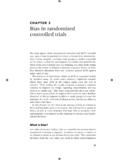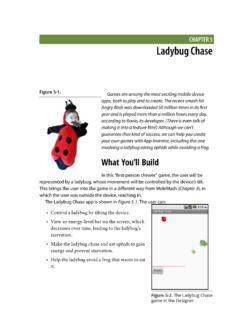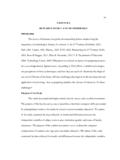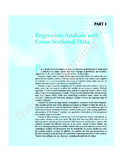Transcription of CHAPTER 4 Violence by intimate partners - who.int
1 CHAPTER 4 Violence byintimate partnersBackgroundOne of the most common forms of Violence againstwomen is that performed by a husband or anintimate male partner. This is in stark contrast to thesituation for men, who in general are much morelikely to be attacked by a stranger or acquaintancethan by someone within their close circle ofrelationships (1 5). The fact that women are oftenemotionally involved with and economicallydependent on those who victimize them has majorimplications for both the dynamics of abuse and theapproaches to dealing with partner Violence occurs in all countries,irrespective of social, economic, religious orcultural group. Although women can be violentin relationships with men, and Violence is alsosometimes found in same-sex partnerships, theoverwhelming burden of partner Violence is borneby women at the hands of men (6, 7). For thatreason, this CHAPTER will deal with the question ofviolence by men against their female s organizations around the world havelong drawn attention to Violence against women,and to intimate partner Violence in their efforts, Violence against women hasnow become an issue of international viewed largely as a human rights issue,partner Violence is increasingly seen as an im-portant public health extent of the problemIntimate partner Violence refers to any behaviourwithin an intimate relationship that causes physical,psychological or sexual harm to those in therelationship.
2 Such behaviour includes:.Acts of physical aggression such as slapping,hitting, kicking and abuse such as intimidation,constant belittling and intercourse and other forms of controlling behaviours such asisolating a person from their family andfriends, monitoring their movements, andrestricting their access to information abuse occurs repeatedly in the samerelationship, the phenomenon is often referred toas battering .In 48 population-based surveys from around theworld, between 10% and 69% of women reportedbeing physically assaulted by an intimate malepartner at some point in their lives (see Table ).The percentage of women who had been assaultedby a partner in the previous 12 months varied from3% or less among women in Australia, Canada andthe United States to 27% of ever-partnered women(that is, women who have ever had an ongoingsexual partnership) in Leo n, Nicaragua, 38% ofcurrently married women in the Republic of Korea,and 52% of currently married Palestinian women inthe West Bank and Gaza Strip.
3 For many of thesewomen, physical assault was not an isolated eventbut part of a continuing pattern of suggests that physical Violence inintimate relationships is often accompanied bypsychological abuse, and in one-third to over one-half of cases by sexual abuse (3, 8 10). Among 613women in Japan who had at any one time beenabused, for example, 57% had suffered all threetypes of abuse physical, psychological and than 10% of these women had experiencedonly physical abuse (8). Similarly, in Monterrey,Mexico, 52% of physically assaulted women hadalso been sexually abused by their partners (11).Figure graphically illustrates the overlap be-tween types of abuse among ever-partnered womenin Leo n, Nicaragua (9).Most women who are targets of physicalaggression generally experience multiple acts ofaggression over time. In the Leo n study, forinstance, 60% of women abused during theprevious year had been attacked more than once,and 20% had experienced severe Violence more thansix times.
4 Among women reporting physicalaggression, 70% reported severe abuse (12). Theaverage number of physical assaults during theprevious year among women currently sufferingabuse, according to a survey in London, England,was seven (13), while in the United States, in anational study in 1996, it was three (5). CHAPTER 4. Violence BY intimate assault on women by an intimate male partner, selected population-based studies, 1982--1999 Country or areaYear ofstudyCoverageSampleProportion of women physicallyassaulted by a partner (%)SizeStudypopulationaAge(years)During theprevious12 monthsIn currentrelationshipEverAfricaEthiopia199 5 Meskanena Woreda673II51510b45 Kenya1984--1987 Kisii District612VI51542 Nigeria1993 Not stated1 000I 31cSouth Africa1998 Eastern CapeMpumalangaNorthern ProvinceNational39641946410 190 IIIIIIIIIIII18--4918--4918--4915--491112 5627281913 Zimbabwe1996 Midlands Province966I51817dLatin America andthe CaribbeanAntigua1990 National97I29--4530dBarbados1990 National264I20--4530c,eBolivia1998 Three districts289I52017cChile19931997 Santiago provinceSantiago1 000310 IIII22--5515--492326/11fColombia1995 National6 097II15--4919 Mexico1996 GuadalajaraMonterrey6501 064 IIIIII5155152717 Nicaragua199519971998 Leo nManaguaNational3603788 507 IIIIIIIII15--4915--4915--4927/20f33/2812 /8f52/37f6928/21fParaguay1995--1996 National, except Chacoregion5 940 III15--4910 Peru1997 Metro Lima (middle-incomeand low-income)
5 359II17--5531 Puerto Rico1995--1996 National4 755 III15--4913gUruguay1997 Two regions545 IIh22--5510eNorth AmericaCanada1991--19921993 TorontoNational42012 300II18--645183d,e27c29d,eUnited States1995--1996 National8 andWestern PacificAustralia1996 National6 300I 3d8dBangladesh19921993 National (villages)Two rural regions1 22510 368 IIII<5015--49194247 Cambodia1996 Six regions1 374 III 16 India1993--19941993--19941995--19961998- -19991999 Tamil NaduUttar PradeshUttar Pradesh, fivedistrictsNationalSix states8599836 69589 1999 938 IIIIIVIIIIII15--3915--3915--6515--4915-- 4911i1437453019i40/26 Papua New Guinea19821984 National, rural villagesPort Moresby628298 IIIhIIIh 6756 Philippines19931998 NationalCagayan de Oro City andBukidnon Province8 4811 660 VII15--4915--491026jRepublic of Korea1989 National707II52038/12fThailand1994 Bangkok619IV REPORT ON Violence AND HEALTHV arious types of abuse generally coexist in thesame relationship.
6 However, prevalence studies ofdomestic Violence are a new area of research anddata on the various types of partner Violence , otherthan physical abuse, are generally not yet figures in Table , therefore, refer exclusivelyto physical assault. Even so, because of methodo-logical differences, the data from these well-designed studies are not directly estimates of abuse are highly sensitive tothe particular definitions used, the manner inwhich questions are asked, the degree of privacy ininterviews and the nature of the population beingstudied (14) (see Box ). Differences betweencountries, therefore especially fairly smalldifferences may well reflect methodologicalvariations rather than real differences in partner violenceIn surveys of partner Violence , women are usuallyasked whether they have experienced any abusefrom a list of specific acts of aggression, includingbeing slapped or hit, kicked, beaten or threatenedTABLE (continued)Country or areaYear ofstudyCoverageSampleProportion of women physicallyassaulted by a partner (%)SizeStudypopulationaAge(years)
7 During theprevious12 monthsIn currentrelationshipEverEuropeNetherlands 1986 National989I20--6021/11c,fNorway1989 Trondheim111 III20--4918 Republic of Moldova1997 National4 790 III15--4457514 Switzerland1994--1996 National1 500II20--606e21eTurkey1998 East and south-eastAnatolia599I14--7558cUnited Kingdom1993 North London430I51612c30cEastern MediterraneanEgypt1995--1996 National7 121 III15--4916j34gIsrael1997 Arab population1 826II19--6732 West Bank and GazaStrip1994 Palestinian population2 410II17--65 52/37fSource: reproduced from reference6with the permission of the population: I = all women; II = currently married/partnered women; III = ever-married/partnered women; IV = married men reporting onown use of Violence against spouse; V = women with a pregnancy outcome; VI = married women --- half with pregnancy outcome, past 3 group included women who had never been in a relationship and therefore were not at risk of partner sample includes all women, rate of abuse is shown for ever-married/partnered women (number not given).
8 EPhysical or sexual physical abuse/severe physical abuse of partner abuse among ever-married/partnered women recalculated from author s sampling techniques assault by could be a family member or close between sexual, physical and psychologicalabuse experienced by women in Leo n, Nicaragua(N= 360 ever-partnered women)Source: 4. Violence BY intimate data on intimate partner Violence more comparableVarious factors affect the quality and comparability of data on intimate partner Violence ,including: inconsistencies in the way Violence and abuse are defined; variations in the selection criteria for study participants; differences resulting from the sources of data; the willingness of respondents to talk openly and honestly about experiences with of these factors, most prevalence figures on partner Violence from different studiescannot be compared directly. For instance, not all studies separate different kinds of Violence , sothat it is not always possible to distinguish between acts of physical, sexual and psychologicalviolence.
9 Some studies examine only violent acts from the previous 12 months or 5 years, whileothers measure lifetime is also considerable variation in the study populations used for research. Many studies onpartner Violence include all women within a specific age range, while other studies interview onlywomen who are currently married or who have been married. Both age and marital status areassociated with a woman s risk of suffering partner abuse. The selection criteria for participantscan therefore considerably affect estimates of the prevalence of abuse in a estimates are also likely to vary according to the source of data. Several nationalstudies have produced estimates of the prevalence of partner Violence --- estimates that aregenerally lower than those obtained from smaller in-depth studies of women s experiences withviolence. Smaller in-depth studies tend to concentrate more on the interaction betweeninterviewers and respondents.
10 These studies also tend to cover the subject matter in much greaterdetail than most national surveys. Prevalence estimates between the two types of studies may alsovary because of some of the factors previously mentioned --- including differences in the studypopulations and definitions of disclosureAll studies on sensitive topics such as Violence face the problem of how to achieve openness frompeople about intimate aspects of their lives. Success will depend partly on the way in which thequestions are framed and delivered, as well as on how comfortable interviewees feel during ,thelengthoftheinterview,whether others are present, and how interested and non-judgemental the interviewer strategies can improve disclosure. These include:nGiving the interviewee several opportunities during an interview in which to behaviourally specific questions, rather than subjective questions such as Have youever been abused?

















